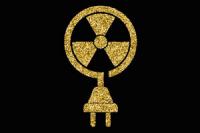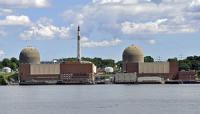-
Identifying the right sites for storing radioactive waste
In 2008, a Swiss government agency identified six regions in Switzerland, approved by the Federal Council, which could be used to store radioactive waste. An EPFL research project has developed a detailed profile of the sites selected to store radioactive waste from Swiss nuclear power plants. The project helped identify the two sites that meet both safety and feasibility requirements.
-
-
U.K. nuclear safety regulations place too low a value on human life

New research has shown that the benchmark used by the U.K. Office for Nuclear Regulation for judging how much should be spent on nuclear safety has no basis in evidence and places insufficient value on human life. The review suggests it may need to be ten times higher — between £16 million and £22 million per life saved.
-
-
A new kind of responder brings special expertise to disasters
An emergency response incident commander should be well-versed on how to respond to all hazards, including the intricacies of radiological and nuclear incidents. Because the hazards associated with radiological or nuclear (rad/nuc) incidents are uniquely challenging to convey accurately to first responders, DHS S&T has developed a solution in the form of the Radiological Operations Support Specialist (ROSS) Program.
-
-
New technique could lead to more efficient, safer uranium extraction
The separation of uranium, a key part of the nuclear fuel cycle, could potentially be done more safely and efficiently through a new technique developed by chemistry researchers at Oregon State University. The technique uses soap-like chemicals known as surfactants to extract uranium from an aqueous solution into a kerosene solution in the form of hollow clusters. Aside from fuel preparation, it may also find value in legacy waste treatment and for the cleanup of environmental contamination.
-
-
NY’s Indian Point nuclear plant to close after many “safety events”

New York’s Indian Point nuclear power plant will close by April 2021, Governor Andrew Cuomo said on Monday. “For fifteen years, I have been deeply concerned by the continuing safety violations at Indian Point, especially given its location in the largest and most densely populated metropolitan region in the country,” Cuomo said. “I am proud to have secured this agreement with Entergy [the plant’s operator] to responsibly close the facility fourteen years ahead of schedule, to protect the safety of all New Yorkers.”
-
-
Chemistry research breakthrough could improve nuclear waste recycling technologies
Researchers have taken a major step forward by describing the quantitative modelling of the electronic structure of a family of uranium nitride compounds – a process that could in the future help with nuclear waste recycling technologies. “In this nuclear age, there is a pressing need for improved extraction agents for nuclear waste separations and recycling technologies,” explained one of the researchers.
-
-
Sandia’s radiation security team helps protect the public in large events
Sandia National Laboratories’ Radiological Assistance Program (RAP) team is one of several Department of Energy (DOE)/National Nuclear Security Administration (NNSA) teams in nine U.S. regions. The teams provide radiological detection support for large public events in Kansas, Oklahoma, Texas, New Mexico, and Arizona. They also help with major public events around the United States, such as Super Bowls or visits from the pope.
-
-
Exercising the U.S. nuclear forensics capabilities
The Domestic Nuclear Detection Office (DNDO) plays an important role in the field of nuclear forensics. In addition to advancing technical capabilities and supporting expertise development, DNDO coordinates with other partners to exercise the U.S. government’s ability to collect nuclear debris samples in the event of a detonation and transport them to laboratories for analysis.
-
-
Bathroom air freshener triggers emergency response at nuclear weapons complex
Late in the afternoon on Wednesday of last week officials at the nuclear weapons complex declared an emergency after finding what they regarded as a suspicious device in a bathroom at the Savannah River National Laboratory in South Carolina. Emergency teams determined that the suspicious device was an air freshener wrapped in paper towels with a flashing light on it.
-
-
First large-scale, citywide test of advanced radioactive threat detection system
Field testing of more than 1,000 networked, mobile radiation sensors in Washington, D.C., yields valuable data for implementing enhanced radiation-detection networks in major U.S. cities. By getting volunteers to walk all day looking for clues, the DARPA-sponsored exercise provided the largest test yet of DARPA’s SIGMA program, which is developing networked sensors that can provide dynamic, real-time radiation detection over large urban areas.
-
-
Immobilizing radioactive waste in glass for millions of years
How do you handle nuclear waste that will be radioactive for millions of years, keeping it from harming people and the environment? It is not easy, but researchers have discovered ways to immobilize such waste – the offshoot of decades of nuclear weapons production – in glass and ceramics.
-
-
Nuclear CSI: Noninvasive procedure could spot criminal nuclear activity
Determining whether an individual – a terrorist, a smuggler, a criminal — has handled nuclear materials, such as uranium or plutonium, is a challenge national defense agencies currently face. The standard protocol to detect uranium exposure is through a urine sample; however, urine is able only to identify those who have been recently exposed. Scientists have developed a noninvasive procedures that will better identify individuals exposed to uranium within one year.
-
-
Nanomaterials help solve the problem of nuclear waste
In the last decades, nanomaterials have gained broad scientific and technological interest due to their unusual properties compared to micrometer-sized materials. Nuclear fuels production, structural materials, separation techniques, and waste management may all benefit from more knowledge in the nano-nuclear technology.
-
-
Suspension of U.S.-Russia plutonium disposal agreement a setback: Expert
Earlier this week the lower house of the Russian parliament approved President Vladimir Putin’s decree on suspending the U.S.-Russian Plutonium Management and Disposition Agreement (PMDA), which requires each nation to dispose of thirty-four metric tons of plutonium from its dismantled nuclear weapons and military stockpiles. Russia has claimed that the United States is violating the agreement by changing its disposition method from irradiating the plutonium as mixed-oxide (MOX) fuel for commercial nuclear reactors to a process called dilute and dispose, but a nuclear expert says that the United States has not violated the terms of the PMDA by proposing that it change its plutonium disposition approach.
-
-
Developing tests for radiation absorbed in nuclear emergency
In a large-scale nuclear or radiological emergency, such as a nuclear detonation, hundreds of thousands of people may need medical care for injuries or illness caused by high doses of radiation. To help save as many people as possible and better prepare the nation for the health impacts of such catastrophic emergencies, HHS will sponsor late-stage development of two tests, known as biodosimetry tests, which can determine how much radiation a person’s body has absorbed.
-
More headlines
The long view
Keeping the Lights on with Nuclear Waste: Radiochemistry Transforms Nuclear Waste into Strategic Materials
How UNLV radiochemistry is pioneering the future of energy in the Southwest by salvaging strategic materials from nuclear dumps –and making it safe.
Model Predicts Long-Term Effects of Nuclear Waste on Underground Disposal Systems
The simulations matched results from an underground lab experiment in Switzerland, suggesting modeling could be used to validate the safety of nuclear disposal sites.
